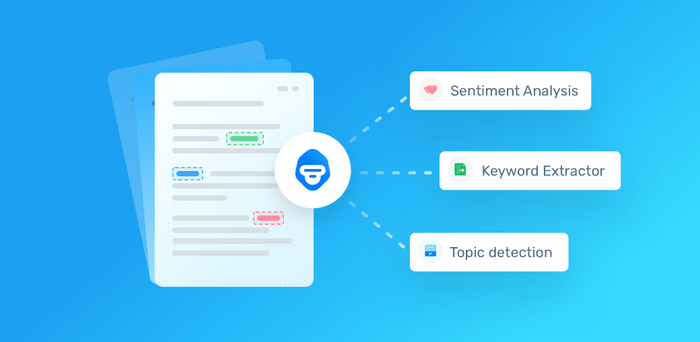What Is Natural Language Understanding (NLU)?

Natural language understanding (NLU) is a subfield of natural language processing (NLP), which involves transforming human language into a machine-readable format.
With the help of natural language understanding (NLU) and machine learning, computers can automatically analyze data in seconds, saving businesses countless hours and resources when analyzing troves of customer feedback.
- NLP Vs NLU: What's The Difference?
- Natural Language Understanding Examples
- Get Started with Natural Language Understanding
NLP Vs NLU: What's The Difference?
Natural language understanding is a subfield of natural language processing.
Both NLP and NLU aim to make sense of unstructured data, but there is a difference between the two.
NLP is concerned with how computers are programmed to process language and facilitate “natural” back-and-forth communication between computers and humans.
Natural language understanding, on the other hand, focuses on a machine’s ability to understand the human language. NLU refers to how unstructured data is rearranged so that machines may “understand” and analyze it.
Look at it this way. Before a computer can process unstructured text into a machine-readable format, first machines need to understand the peculiarities of the human language.
Natural Language Understanding Examples
1. Automatic Ticket Routing
A useful business example of NLU is customer service automation. With text analysis solutions like MonkeyLearn, machines can understand the content of customer support tickets and route them to the correct departments without employees having to open every single ticket. Not only does this save customer support teams hundreds of hours, but it also helps them prioritize urgent tickets.
According to Zendesk, tech companies receive more than 2,600 customer support inquiries per month. Using NLU technology, you can sort unstructured data (email, social media, live chat, etc.) by topic, sentiment, and urgency (among others). These tickets can then be routed directly to the relevant agent and prioritized.
Try out MonkeyLearn’s pre-trained machine learning models automatically tag your customer service tickets, or train your own for more accurate results.
2. Machine Translation (MT)
Accurately translating text or speech from one language to another is one of the toughest challenges of natural language processing and natural language understanding.
Using complex algorithms that rely on linguistic rules and AI machine training, Google Translate, Microsoft Translator, and Facebook Translation have become leaders in the field of “generic” language translation.
You can type text or upload whole documents and receive translations in dozens of languages using machine translation tools. Google Translate even includes optical character recognition (OCR) software, which allows machines to extract text from images, read and translate it.
3. Automated Reasoning
Automated reasoning is a subfield of cognitive science that is used to automatically prove mathematical theorems or make logical inferences about a medical diagnosis. It gives machines a form of reasoning or logic, and allows them to infer new facts by deduction.
Simply put, using previously gathered and analyzed information, computer programs are able to generate conclusions. For example, in medicine, machines can infer a diagnosis based on previous diagnoses using IF-THEN deduction rules.
4. Automatic Ticket Tagging & Reasoning
Text analysis solutions enable machines to automatically understand the content of customer support tickets and route them to the correct departments without employees having to open every single ticket. Not only does this save customer support teams hundreds of hours,it also helps them prioritize urgent tickets.
According to Zendesk, tech companies receive more than 2,600 customer support inquiries per month. Using NLU technology, you can sort unstructured data (email, social media, live chat, etc.) by topic, sentiment, and urgency (among others). These tickets can then be routed directly to the relevant agent and prioritized.
Try out no-code text analysis tools like MonkeyLearn to automatically tag your customer service tickets. Just sign up for free.
5. Question Answering
Question answering is a subfield of NLP and speech recognition that uses NLU to help computers automatically understand natural language questions.
For example, here’s a common question you might ask Google Assitant: “What’s the weather like tomorrow?”
NLP tools can split this question into topic (weather) and date (tomorrow), understand it and gather the most appropriate answer from unstructured collections of “natural language documents”: online news reports, collected web pages, reference texts, etc
By default, virtual assistants tell you the weather for your current location, unless you specify a particular city. The goal of question answering is to give the user response in their natural language, rather than a list of text answers.
Get Started with Natural Language Understanding in AI
The above are only a handful of NLU examples and applications. AI technology has become fundamental in business, whether you realize it or not. Recommendations on Spotify or Netflix, auto-correct and auto-reply, virtual assistants, and automatic email categorization, to name just a few.
Learn how to extract and classify text from unstructured data with MonkeyLearn’s no-code, low-code text analysis tools. With natural language processing and machine learning working behind the scenes, all you need to focus on is using the tools and helping them to improve their natural language understanding.
Request a demo and begin your natural language understanding journey in AI.

Rachel Wolff
January 8th, 2021






